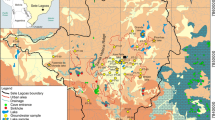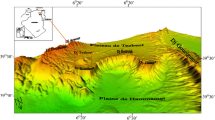Abstract
A Triassic carbonate unit has been intensively drained by zinc and lead ore mines and numerous borehole fields since the nineteenth century. Its groundwater recharge has increased due to: pumping of water from boreholes, mining activity, and urbanization. An approach to determine the amounts of the recharge at a variety of spatial scales is presented in the paper. Different methods were used to identify and quantify recharge components on a regional and local scale: mathematical modelling was performed for four aquifers included in an aquifer system, an analytical estimation based on the assumption that an average recharge is equal to the average discharge of the hydrogeological system—for six man-made drainage centres, and the method of water level fluctuation (WLF) was applied in one observation borehole. Results of modelling have been supplemented by observation of environmental tracers (δ18O, δ2H, 3H), noble gases temperatures, and 4Heexc in groundwater. The regional aquifer’s current recharge according to estimations performed by means of modelling varies from 39 to 101 mm/year on average. Depending on the aquifer site the average precipitation ranges from 779 to 864 mm/year. In the confined part of the aquifer average recharge ranges from 26 to 61 mm/year. Within outcrops average recharge varies from 96 to 370 mm/year. Current recharge estimated by the analytical method for man-made drainage centres varies from 158 up to 440 mm/year. High values are caused by different recharge sources like precipitation, induced leakage from shallow aquifers, and water losses from streams, water mains and sewer systems. Pumping of water, mining and municipal activities constitute additional factors accounting for the intensified recharge.











Similar content being viewed by others
References
Anderson MP, Woessner WW (1992) Applied groundwater modeling. In: Simulation of flow and adjective transport. Academic Press Inc. Harcourt Brace Jovanovich Publishers, San Diego, p 381
Czaja S (2001) Mining and hydrological transformations in Upper Silesia from the fifteenth to the nineteenth century. Geogr J 167(1):57–71
De Vries JJ, Simmers I (2002) Groundwater recharge: an overview of processes and challenges. Hydrogeol J 10(1):5–17
Harbaugh AW, Banta ER, Hill MC, McDonald MG (2000) MODFLOW−2000, The US geological survey modular ground-water model—user guide to modularization concepts and ground-water flow process. Open File Report 00–92. Reston, Virginia
Healy RW, Cook PG (2002) Using groundwater levels to estimate recharge. Hydrogeol J 10(1):91–109
Johnston RH (1997) Sources of water supplying pumpage from regional aquifer systems of the United States. Hydrogeol J 5(2):54–63
Kowalczyk A (2003) Formation of groundwater resources in carbonate aquifers of the Silesian-Cracow Triassic under a human impact (in Polish). University of Silesia, pp. 195
Kowalczyk A (2005) The impact of intense urban and mine abstraction of water on groundwater resources of the regional Triassic aquifer systems (Southern Poland). In: Sahuquillo A, Martinez-Cortina L, Sanchez-Vila X (eds) Groundwater intensive use. IAH selected papers on hydrogeology. A.A. Balkema, Rotterdam 7:189–197
Kowalczyk A, Miotliński K, Rubin K (2004) Groundwater flow modelling of the multilayer system in the area of Tarnowskie Góry. In: Gurwin J, Staśko S (eds) Modelowanie przepływu wód podziemnych. Acta Universitatis Wratislaviensis No 2729. (in Polish): 105–119
Kropka J (2002a) Problems related to groundwater balance assessment for urban and mining areas. (in Polish). In: Proceedings of the XIVth Conference: Problemy wykorzystywania wód podziemnych w gospodarce komunalnej. Gospodarowanie zasobami wód podziemnych. Częstochowa 11–12. 04. 2002, pp 86–93
Kropka J (2002b) Quantitative analysis of supply from anthropogenic sources to mine workings of closed zinc-lead are mines in the Bytom Trough (southern Poland). In: Proceedings of the international conference uranium mining and hydrogeology III and IMWA Symposium, Freiberg, Springer, pp 1075–1082
Kropka J, Respondek J (2000) Hydrogeological and mining problems of the central dewatering system in mined-out ore workings in the Bytom Trough (southern Poland). Przegląd Geologiczny 48(8):727–735
Lerner DN (1997) Too much or too little: recharge in urban areas. In: Chilton et al. (eds) Groundwater in the urban environment: problems, processes and management, Vol 1. A.A. Balkema, Rotterdam, pp 41–48
Lerner DN (2002). Identifying and quantifying urban recharge: a review. Hydrogeol J 10(1):143–152
Lerner DN, Issar AS, Simmers I (1990) Groundwater Recharge. A guide to understanding and estimating natural recharge. Vol 8. IAH, Verlag Heinz Heise, pp 345
Macioszczyk T (1999) Mathematical descriptions of groundwater flow and migration for modeling and management of their resources (in Polish). Biuletyn Panstwowego Instytutu Geologicznego. Vol 388, Warszawa: 157–178
McDonald MG, Harbaugh AW (1988) A Modular three-dimensional finite-difference ground-water flow model. Techniques of Water-Resources Investigations of the United States Geological Survey, Book 5, Chapter A1, US Government Printing Office, Washington DC
Motyka J. (1975) Study on aquifer properties of Triassic rocks in the area of Olkusz ore mines. PhD Thesis. Academy of Mining and Metallurgy, (in Polish) Kraków: 135 pp
Motyka J (1998) A conceptual model of hydraulic networks in carbonate rocks, illustrated by examples from Poland. Hydrogeol J 6:469–482
Pazdro Z (1983) General Hydrogeology (in Polish). Wydawnictwa Geologiczne, Warszawa, pp 575
Różkowski A (ed) (1990) Fissure-karst groundwater basins of the Cracow-Silesian monocline and problems of their protection. Monograph CPBP 04.10. Vol.57 (in Polish). Warszawa: wyd. SGGW-AR: pp 123
Sanford W (2002) Recharge and groundwater models: an overview. Hydrogeol J 10(1):110–120
Sawicki J (2000) The changes of natural infiltration of precipitation into aquifers as the result of a deep mining groundwater drainage (in Polish). Ofic. Wyd. Pol. Wrocł., Wrocław: 1–174
Scanlon BR, Cook PG (2002) Theme issue on groundwater recharge. Hydrogeol J 10(1):3–4
Scanlon BR, Healy RW, Cook PG (2002) Choosing appropriate techniques for quantifying groundwater recharge. Hydrogeol J 10(1):18–39
Zuber A, Osenbrück AK, Weise SM, Kowalczyk A, Rubin K, (2005) Results of investigations of noble gases in Lubliniec-Myszków major aquifer (MA-327) (Poland) (in Polish). In: Scientific Works of University of Silesia “Hydrogeology of urbanised and industrialised areas”. Katowice, 2:189–196
Author information
Authors and Affiliations
Corresponding author
Rights and permissions
About this article
Cite this article
Kowalczyk, A., Witkowski, A.J. Groundwater recharge of carbonate aquifers of the Silesian-Cracow Triassic (southern Poland) under human impact. Environ Geol 55, 235–246 (2008). https://doi.org/10.1007/s00254-007-0999-9
Received:
Accepted:
Published:
Issue Date:
DOI: https://doi.org/10.1007/s00254-007-0999-9




